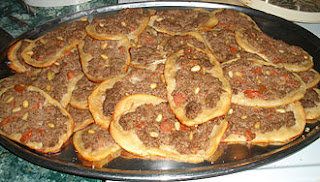Palestinians bake a variety of different kinds of breads: they include khubz, pita and markook and taboon. Khubz is an everyday bread and is very similar to pita. It often takes the place of utensils; It is torn into bite size pieces and used to scoop various dips such as hummus or fool. Markook bread is a paper-thin unleavened bread and when unfolded it is almost transparent. Taboon receives its name from the ovens used to bake them.
Musakhan is a widely popular Palestinian dish composed of roasted chicken, with fried onions, sumac, allspice, safron and pine nuts atop one or more taboons. The dish is usually eaten with the hands and served with cut lemon on the side. In April 2010, Palestinians were entered into the Guinness Book of World Records for largest Musakhan dish.











